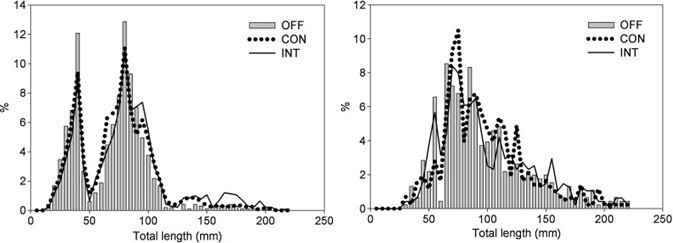Fish avoidance behaviour in the trawl mouth at night was investigated in the extremely shallow and turbid Lake Neusiedl in Austria. To evaluate fish reactions, a fixed frame benthic trawl with three electricity modes (without electricity, with continuous electricity and with interrupted electricity) was used and the captured fish abundances, biomasses and size structures were compared between modes. Simultaneously, the dual-frequency identification sonar (DIDSON) monitored fish abundance and size in front of and beside the trawl mouth during all tows. White bream (Blicca bjoerkna), bleak (Alburnus alburnus) and razor fish (Pelecus cultratus) were dominant fish species in the trawl catches. We did not find differences in fish abundance or biomass when the tows with different electricity modes were compared. The length frequency distribution of fish was not significantly different between modes, but trawls with the two electrified modes contained a higher proportion of fish larger than 130 mm than trawls with the non-electrified mode. Additionally, the DIDSON recordings did not display any significant differences in abundance, length frequency distribution and from length–weight relationships calculated biomass between the electrical modes. Not even the two avoidance behaviour categories used as indicators of trawling error displayed significant differences between avoidance and biomass. Our results indicate that based on trawling abundance and biomass comparisons, and supported by observations by DIDSON, all electrical modes were similarly effective for all size groups of fish. The study found minimal avoidance reactions by the dominant fish species in the trawl mouth opening when a relatively small fixed frame trawl was used to sample fish in a shallow and turbid lake at night.
Keywords: Alburnus alburnus; biomass; bleak; Blicca bjoerkna; DIDSON; electrified trawl; fish abundance; Lake Neusiedl; Pelecus cultratus; razor fish; white bream

